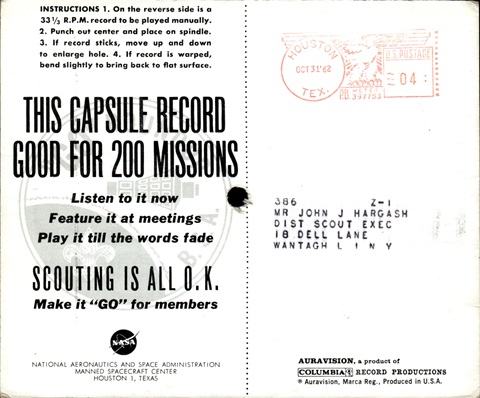Space Cover 784: Boy Scout Audio PostcardsThis week is a bit different. I wanted to share something from my collection that I don't know much about and solicit input from the community. Also, instead of a cover it is a postcard, printed on heavy cardstock with an October 31st, 1962, meter cancellation paid 4 cents from Houston, Texas. It was mailed to a District Scout Executive in Wantagh, Long Island, New York.
Looking closer, it is apparent that this card was produced for the Boy Scouts of America (BSA) and is in fact a record with an audio recording on the reverse. It was mailed so that it could be played at an upcoming scout meeting. At the top left corner on the address side, the card gives the recipient a clear instruction on how to prepare for playing.
Instructions - On the reverse side is a 33 1/3 R.P.M. record to be played manually.
- Punch out center and place on spindle.
- If record sticks, move up and down to enlarge hole.
- If record is warped, bend slightly to bring back to flat surface.
The "capsule" record is certified for 200 plays and the scout leaders are encouraged to feature it at meetings and play it "till the words fade." The recording is listed as being made by AURAVISION, a product of COLUMBIA record productions.The reverse of this card is shown below, it features Alan Shepard, Project Mercury Astronaut, and First Class Scout from Derry New Hampshire. It features the BSA logo and an image of Shepard from his NASA portrait photo shoot wearing the same tie and jacket.
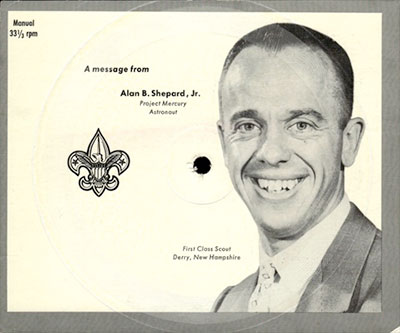
Upon receiving the record at my home, I desperately wanted to hear it but was unsure how well it would play, if at all. Holding under some light, I confirmed that the circular grooves looked clean and the card was flat. The central hole had already been punched out with a small tear on the inner radius (probably due to the instructions step #3 above), meaning it was most likely played at least a few times.
I had never attempted to play something that wasn't round and before placing the needle down realized that the rectangular card spinning gave me enough of a visual distraction that I needed to focus my eyes to be extra careful in placing down the arm of the player. The card says to play manually, however my record player automatically starts rotating once the arm is raised and has auto-reject for when the record is done playing or the needle is slipping.
Without the ability to turn these two features off, I needed to get comfortable hitting the right spot. After a few tentative attempts I was successful, and quickly discovered aiming for entry on the wide part of the card near where the side of the card transitions into the corner was the best bet.
After listening several times, I decided to make a recording to share. I connected the line-out from the player to the line-in of my computer's soundcard and made a direct recording. I've linked this mp3 file below for your enjoyment, it is a bit "crunchy" so I'd advise to start at a lower volume and adjust the level to your preference from there. I won't spoil the message, instead encouraging you to listen for yourself, I had not heard this audio from Shepard previously, have you?
Shepard Audio RecordingUpon discovering and listening to this card, I've since searched and found two others, one from Gus Grissom, and another from John Glenn. I was able to play the Grisson card in the same manner and have included his recording below. The Glenn record needs to be cleaned so I have yet to attempt a play of it.
Grissom Audio Recording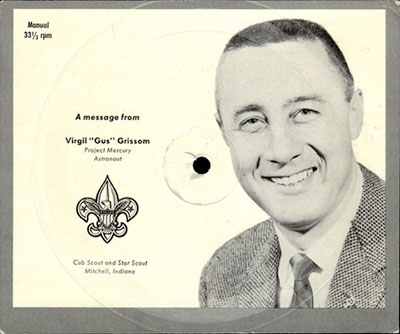
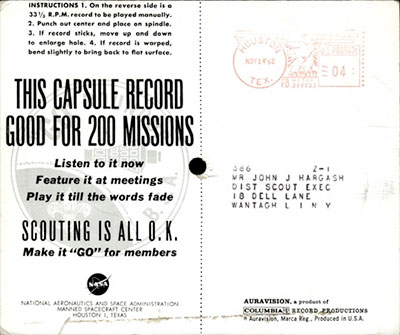
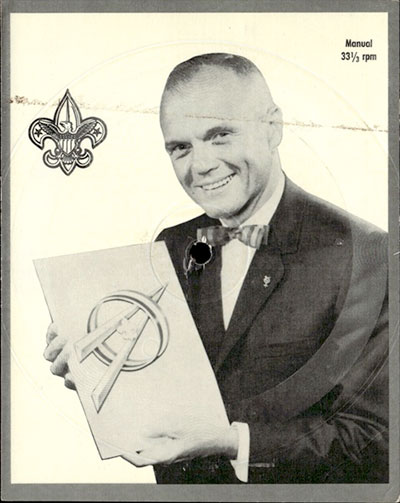
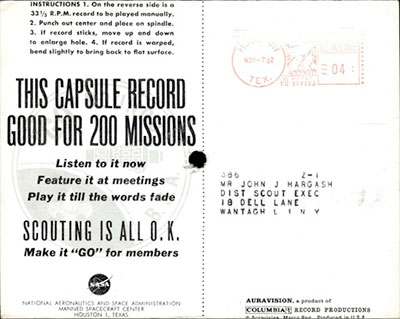
I'll end with a few requests. Have you seen other records from the remaining four Mercury 7 astronauts? Is someone able to take these two audio recordings and clean them up by adjusting the levels and reducing the static? Does anyone have recommendations for cleaning the recording surface? I'm unsure since this card isn't vinyl material and I don't want to ruin it. Thank you!!











